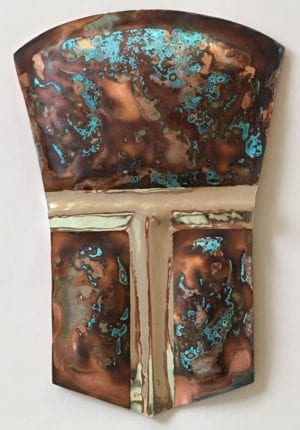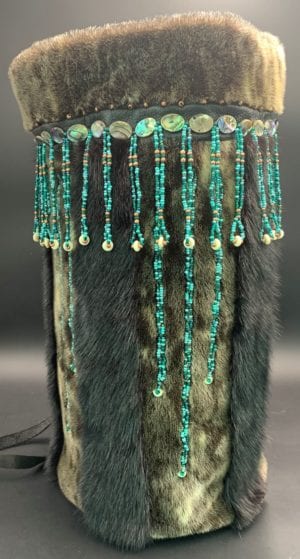
By Teal Hansen
For The Cordova Times
Ilanka Cultural Center will add Jennifer Younger’s copper tináa and Christine Belgarde’s bidarki bag to the museum collection, thanks to the Rasmuson Foundation’s Art Acquisition Fund grant and with the assistance of Museums Alaska.
Jennifer Younger crafted “Backbone of our Ancestors” in 2017 out of 18-gauge painted copper with a partial silver plating. “Tináa” means “copper shield” in the Tlingit language. Younger is Tlingit of the Eagle Kaagwaantaan clan in Yakutat and now calls Sitka her home. Yakutat elders taught Younger that the T form on the copper represents the backbone of our ancestors.
Younger draws inspiration from traditional Tlingit designs, historic artifacts, spruce root basket weaving patterns, and from the contrast and texture of metals.
“I am fulfilling my dream of pursuing something related to traditional Tlingit art, while having the freedom to express my own style,” Jennifer said.
Owning copper was traditionally considered a sign of wealth and stature in Northwest Coast indigenous cultures. Some elders have said that tináas were never used as shields, and others report that tináas literally were copper shields — such is the way of oral history.
Prior to Euro-American contact, the Yakutat region was inhabited by the Eyak people. Tlingits moved north and pushed most Eyaks into the mouth of the Copper River and near present-day Cordova. Prolonged contact in the Yakutat area led to the formal union of the two distinct cultures.

Belgarde hand-sewed a quyaq atmak (kayak backpack) in 2015 out of seal hide, mink fur and leather, and decorated it with abalone, copper beads and seed beads. The seal fur was harvested by Belgarde on her last seal hunt and the mink fur is recycled from an old parka. This contemporary women’s backpack is a modern version of the skin, or gut-skin, hunting bags used by Alutiiq and Chugach-region sea hunters. The bags held spare hunting tools, a sewing kit for repairing tears in quyat (kayaks) skin covering, and other necessities.
Belgarde immediately started making “Falling Rain” after seeing a fellow skin-sewer’s bidarki bag. It took three full days for her to complete, but once inspired, she could not set down her needle until it was finished.
“Experience allows you to put your wings on to try something a little different and creative,” Belgarde said. “I felt an urge to make this bag that I could not ignore.”
Before moving to Cordova, Belgarde spent her youngest years living at a White Alice Communication site near Boswell Bay on Hinchinbrook Island. In the fall of 1956, Belgarde was born in an open skiff behind Spike Island. In the middle of the night, her mother made the approximately 20-mile boat ride to Cordova to have her 11th child. However, Belgarde made her appearance before her mother was able to reach shore. Belgarde experienced a remote childhood in an unmodern time.
Taught by her mother, Belgarde started beading and sewing at the age of 6. Her mother was Iñupiaq from the Kotzebue area, but was sent to White Mountain’s Catholic Mission Home after her mother’s death. This resulted in cultural dissociation. Having been removed from her mother’s heritage, Christine adopted local traditions and cultural skills. When she had family to care for, she sewed at night to keep food on the table. The artist has taught several skin-sewing and beading classes and her expertise is sought out by fellow crafters.
“Sugpiaq” means “real person,” and is the way our people described themselves prior to Euro-American contact. They were maritime people who developed highly maneuverable and seaworthy skin-covered quyat for traveling and hunting on rough, stormy seas.
Carried by Chugach region sea hunters, these kayak bags — known by many as bidarki bags — carried hunting necessities and kits needed for repairing their boat skins. Preparing for a hunting or fishing trip, Sugpiaq hunters filled their quyat with useful items such as wooden containers of fresh food and water; sleeping blankets; and inflated seal bladders for emergency buoyancy —antiquated personal flotation devices. Each hunter also carried a special atmak (backpack) with smaller necessities: harpoons and arrowheads to equip hunting tools, and needles, sinew and skin to patch tears in the skin of their quyaq. In our more recent history, they would carry ammunition and tobacco. Sea hunters and fishermen’s atmak were normally crafted from intestine skin, like seal gut or sea lion esophagus, or sheared animal hide. These bags were exquisitely made and decorated beautifully because adorning clothing and tools was considered a sign of respect for the animals a hunter pursued.
Younger’s copper tináa and Belgarde’s bidarki bag will be significant additions to our cultural museum. Ilanka is honored to receive this grant, and these beautiful handcrafted artworks will be proudly on display once we open our doors again.
Teal Hansen is the cultural center coordinator for Native Village of Eyak’s Ilanka Cultural Center and Museum.





